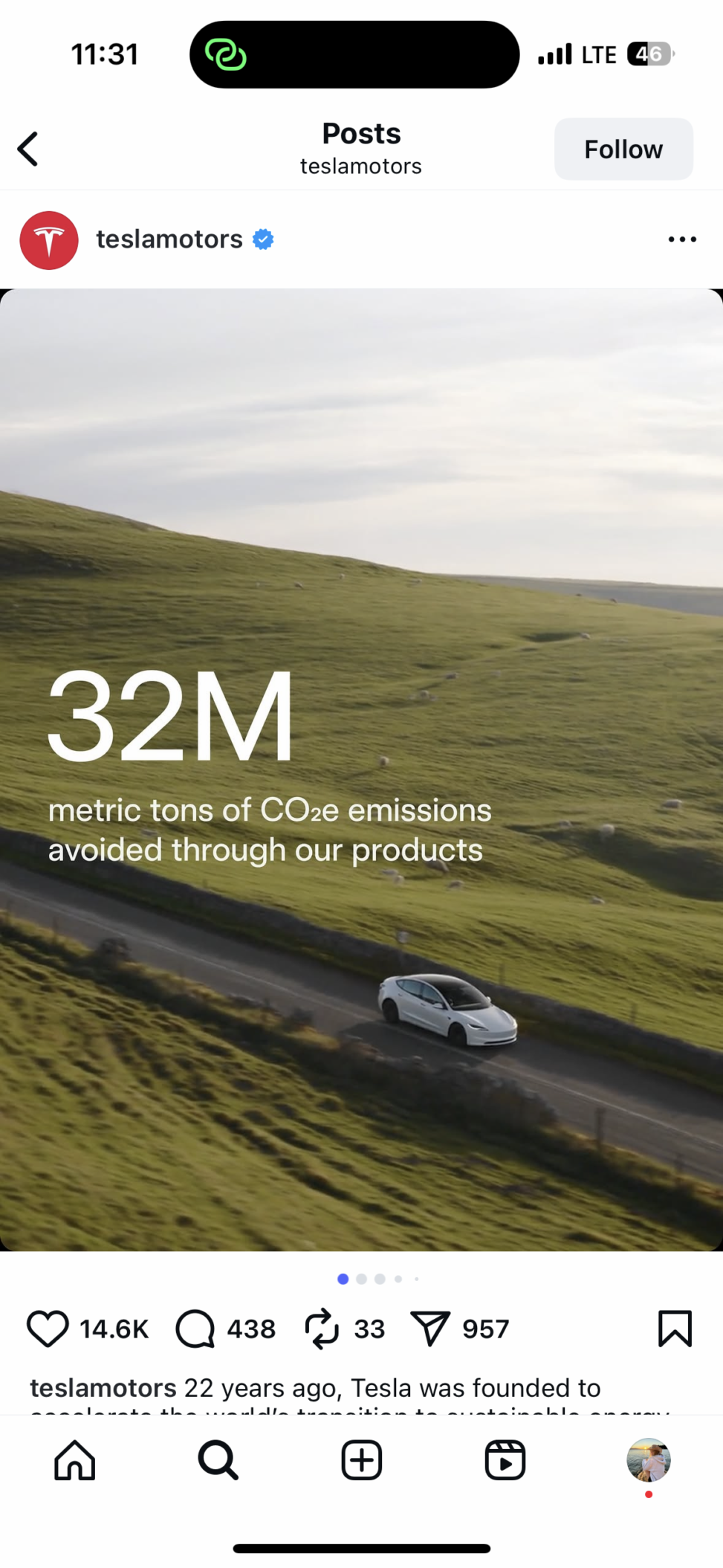Tesla and the Green Image: Marketing vs. Reality
Tesla’s Instagram ad uses natural scenery and minimalist design to project ecological and social responsibility, but this is a form of greenwashing. The campaign’s thumbnail image shows a sleek Tesla on an open road framed by green fields and a bright horizon. The ad suggests ecological purity, yet it masks the environmental and social costs of Tesla’s production and supply chain.
At the top of this image, there is a clean white sky, which suggests a pollution-free environment, and gives the audience the idea that Teslas contribute to a cleaner, pollution-free world. In reality, Tesla’s Gigafactory in Austin, Texas, has been reported to release significant amounts of pollution. These emissions come from the electricity powered by fossil fuels, and from the chemical reactions in lithium-ion battery production, which release greenhouse gases.
The focal point of the image is the white car, as it stands out on the green grass surrounding it. The car is also the only point that is in focus. There is a slight blur to the rest of the image. This blur illustrates that the car is moving fast, showing Tesla’s audience that their all-electric vehicles provide speed and power for optimal transportation. The car is driving on an empty wide-open road, symbolising freedom, while the lush green field suggests eco-friendly travel. They emphasise the color green to create a physiological sense of eco-friendlyness as well as the warm, gentle sunlight over the image for hope and positivity. All these details are evidence of greenwashing and semiotics theory.
The information the ad provides is vague and misleading. In the middle left-hand side of the image, there is white minimalist text which matches the colour of the sky and car, creating a modern look. The text says “32M metric tons of CO2e emission avoided through our product.” This is delusive because it does not specify the time frame and ignores emissions from production. Phrases like “Our future is sustainable” and “cleaner, safer & more affordable than fossil-fuel cars” suggest Tesla is contributing positively to the environment. These claims lack measurable proof, making them potentially misleading and can all be considered greenwashing.
The advertisement portrays Tesla as socially responsible, particularly regarding driver safety and societal well-being. Tesla claims that Autopilot saves lives and is 10x safer than the average U.S. driver. They also claimed it is safest in their category and suggested Tesla is actively improving public safety, yet they provide no proof behind these statements. Further, there have also been reports of poor labour practices. Allegedly, some employees were left unpaid and did not receive compensation for overtime work. Additionally, in November 2024, reports suggested that a malfunctioning furnace door had subjected workers to temperatures reaching up to 100 degrees Fahrenheit. Reports indicate that this issue lasted several months during the production of the Model Y.
According to Daniel Pereira, Tesla’s Target demographic is primarily young professionals, aged 25 to 55, working in the tech industry, finance or as entrepreneurs. This is because Tesla cars are expensive. Geographically, most Tesla owners live in cities. The biggest customer market for Tesla cars is technologically advanced regions in China, Europe and the United States”(An Overview of Artificial Intelligence in Automobile Industry). Even though I don’t fit into Tesla’s typical demographic, I believe this popped up on my feed because I work in social media marketing, and have made vehicle ads in the past.
The main purpose of this ad is to get you to buy the car. However, it’s not just about the car itself, but the ideology of the Tesla lifestyle: clean energy, innovative, and socially responsible. It suggests that buying a Tesla is equal to helping the planet and supporting social progress.
Tesla uses strategies like greenwashing and semiotics to influence their audience. They combine vague ecological messaging, impressive statistics, and social safety claims to make purchasing a Tesla feel like the “right” choice. Their messaging appeals to your values, emotions, and sense of eco-conscious responsibility. The advertisement reduces complicated problems of climate change, fossil fuel pollution, and traffic deaths into simple numbers or phrases. This creates the perception that Tesla vehicles directly solve these problems. By combining ecological and social responsibility claims, the ad makes owning a Tesla feel like a personal ethical decision, not just a financial or practical one. These 3 strategies are known as emotional, cognitive, and behavioural influences.
I appreciate how clever and detailed the ad is. It is very minimalistic, modern and visually appealing, but the truth behind the carbon footprint of Tesla’s production leaves me feeling deceived and misrepresented, too.
In conclusion, the imagery works to make Tesla look more than just a car company. It sells the identity of being responsible, modern, and environmentally conscious. So you feel like your purchase is making a positive difference. Tesla constructs a socially and ecologically responsible identity through imagery, but this is undermined by reality. This ad is a great example of greenwashing and how a visual image can be so powerful but yet so deceptive. Tesla’s ad shows how advertising transforms urgent collective challenges such as climate change into purchasable lifestyles.
Bibliography
Pereira, Daniel. 2024. “Tesla Target Market.” Business Model Analyst. https://businessmodelanalyst.com/tesla-target-market/?srsltid=AfmBOooDLwhYCvTJqd07_pWb1AUQSQM89hY8ExTnNv_uhWPWJasayRfd.
Hartono, F. 2023. SK PCB Keff Gregory Hartono [19020030] – Full Text. Bandung, Indonesia: Institut Teknologi Bandung. https://digilib.itb.ac.id/assets/files/2023/MjAyMyBTSyBQUCBKZWZmIEdyZWdvcnkgSGFydG9ubyAgIFsxOTAyMDAzMF0gLSBGdWxsIFRleHQucGRm.pdf.
Michael Samsu Koroma, Daniele Costa, Maeva Philippot, Giuseppe Cardellini, Md Sazzad Hose,Thierry Coosemans, Maarten Messagi. 2022. “Environmental Impacts of Electric Vehicles: A Comprehensive Analysis.” Science of the Total Environment 838: 156–789. https://www.sciencedirect.com/science/article/pii/S0048969722019520?via%3Dihub.
Nagra, Ankita. 2021. An Overview of Artificial Intelligence in Automobile Industry: A Case Study on Tesla Cars. ResearchGate. https://www.researchgate.net/publication/349298066_An_Overview_of_Artificial_Intelligence_in_Automobile_Industry_-A_Case_Study_on_Tesla_Cars.
Jorge A Llamas-Orozco, Fanran Meng, Gavin S Walker, Amir F N Abdul-Manan, Heather L MacLean, I Daniel Posen, Jon McKechnie. 2023. “AI in Sustainable Transportation Systems.” PNAS Nexus 2(11): 1–12. https://academic.oup.com/pnasnexus/article/2/11/pgad361/7451193.
ChatGPT, AI language model, “Assistance with Creating an Detailed Outline and Formatting Citations,” OpenAI, September 30, 2025, https://chat.openai.com/.
Catherine Rhodes, “Human Rights Concerns at Tesla’s Texas Gigafactory,” UAB Institute for Human Rights Blog, March 30, 2025, https://sites.uab.edu/humanrights/2025/03/30/human-rights-concerns-at-teslas-texas-gigafactory/#:~:text=Widespread%20criticism%20has%20also%20been,the%20contractors’%20lack%20of%20responsibility.


Amira Alam
I think Isabella made her point effectively through a well-thought-out analysis and critique supported by a wide range of credible sources. She made excellent use of the resources available to her, citing journal articles, websites, and even AI tools to strengthen her arguments and provide context. This level of research shows a commitment to understanding the broader implications of Tesla’s marketing strategies.
Her photo analysis is particularly well-executed, offering a detailed and thoughtful description of the image and its intended message. She draws meaningful conclusions from the visual elements, paying close attention to the minimalist design of the advertisement and how it reflects Tesla’s clean, ecological aesthetic. With careful reasoning, Isabella highlights the deceptive nature of the ad’s copy – “2M metric tons of CO₂e emissions avoided through our products.” She points out that this statement lacks critical context, such as the timeframe of those emissions or how many emissions were produced during production in the first place.
Rather than rushing to condemn the company, Isabella takes the reader through a logical, step-by-step process supported by research and visual analysis. Once her argument is fully established, she effectively concludes that the advertisement exemplifies greenwashing. I also agree with her point that the ad promotes not only the product but the brand’s image as a whole. Tesla markets itself as a lifestyle and symbol of intelligence and innovation rather than as a manufacturer of tangible goods. Isabella’s perspective, grounded in both advertising and consumer awareness, adds valuable insight and depth to her critique.
– Amira (T00741086)